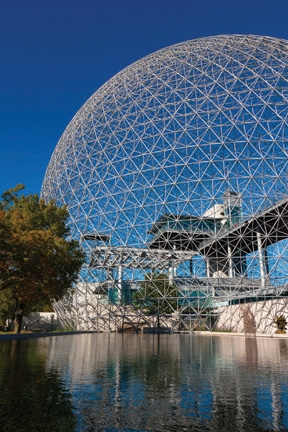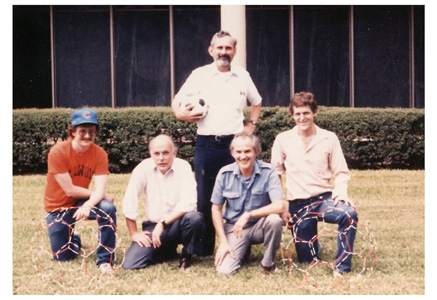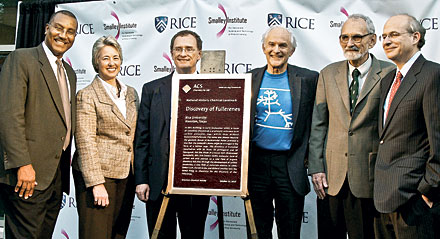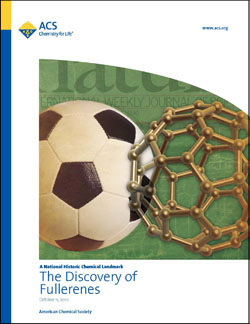Discovery of Fullerenes
Designated October 11, 2010, at the Richard E. Smalley Institute for Nanoscale Science and Technology at Rice University in Houston, Texas.
Landmark Lesson Plan: Discovery of Fullerenes
Truncated icosahedron: technical term for a soccer ball in the United States, a football everywhere else. The scientists who vaporized the graphite to produce C60 named the new carbon allotrope buckminsterfullerene (shortened to fullerenes or buckyballs) because the geodesic domes designed by inventor and architect Buckminster Fuller provided a clue to the molecule’s structure.
Contents
An Idea and a Machine
Carbon, the basis of life, is one of the most common elements and one of the most studied; it comprises the whole discipline of organic chemistry. A study of pure carbon would not seem all that exciting to most chemists. In 1984 Richard Smalley found himself less than thrilled when he received a request from Harry Kroto, a chemist at the University of Sussex, to use equipment in Smalley’s laboratory at Rice University to study a special kind of carbon molecule.1
“In retrospect,” Kroto writes, “…I seem to have been fascinated by various peculiar aspects of carbon chemistry for much of my research career.”2 Kroto wanted to investigate the origins of the long linear carbon chain molecules that he, together with Canadian radio astronomers, had discovered in interstellar space several years earlier. Kroto was convinced that these unusual, long flexible molecules had been created in the atmospheres of carbon-rich red giant stars and wanted to prove this contention using Smalley’s laser-supersonic cluster beam apparatus. This experiment also could be a preliminary pilot for a rather more complicated experiment that might solve a long-standing puzzle in astronomy—the carriers of the mysterious and now legendary diffuse interstellar bands. The discovery of the fullerenes pushed pursuit of the carbon chain interstellar band project out of further consideration, but others have pursued it, so far without positive results.3
Clusters of any element can be studied in the AP2 (pronounced app-two), the colloquial name of Smalley’s machine. Operators fire an intense laser pulse at a target, which creates a hot vapor above it. The laser generates temperatures reaching tens of thousands of degrees, hotter than the surfaces of most stars. As the vapor cools, the evaporated atoms align in clusters. A high pressure burst of gas sweeps the vapor through the machine into a vacuum chamber, where clusters begin to condense as the vapor cools. A second laser pulse ionizes the clusters, pushing them into a mass spectrometer, where the clusters are analyzed.4

Discovery of Fullerenes
In 1984, Kroto met Robert Curl, an old friend, at a conference in Austin, Texas. Curl told Kroto about his collaboration with Smalley in studying atom clusters in Smalley’s machine. Kroto was intrigued, and he accompanied Curl back to Houston, where he examined the machine and immediately saw the possibility of putting carbon in it to explore his theory about the formation of carbon chains in the atmosphere of stars.5 Smalley was less intrigued. He and Curl were busy studying semiconductor clusters and he declined initially to free up time on the apparatus.6
Kroto’s disappointment grew when he learned that a team of scientists at the Exxon Corporate Research Science Laboratory in Annandale, New Jersey, had performed experiments using lasers to vaporize graphite to form carbon clusters. The Exxon scientists, Eric Rohlfing, Donald Cox, and Andrew Caldor, had used a machine, similar to the AP2, built by Smalley’s group at Rice. The Exxon team found that carbon clusters of more than forty atoms tended to be an even number for some reason. “Because we were trying to avoid needless overlap and competition with the Exxon group,” Smalley wrote, “their steady progress in the field was yet another disincentive to taking up work on carbon clusters at Rice.”7
Despite the Exxon work, Smalley relented a year later and agreed to let Kroto use the cluster beam apparatus. Curl telephoned to ask whether Kroto wanted the Rice team to carry out the experiment and send him the data or if wanted to come to Houston. Kroto says “one thing was certain in my mind: I had not waited this long to have my experiments carried out by others...”8 He “pinched” money from his wife, packed his bags, and arrived in Houston a few days later, in late August.9
Kroto, Smalley, and Curl conducted the study, with the assistance of three graduate students, James Heath, Sean O’Brien, and Yuan Liu. On August 23, before Kroto’s arrival, Smalley had the students load carbon in the apparatus as a test of the new experiments.10 On September 1, four days after Kroto landed in Houston, the experiments began in earnest. The students ran the machine with Kroto directing the experiments. Two significant results emerged from the feverish ten days of experiments: first, the team found, as Smalley put it, “Kroto’s long carbon snakes”; second, the scientists also observed, again according to Smalley, “a previously unknown molecule of pure carbon.”11
The lab book for September 2 first notes the unknown molecule. Then on Wednesday, September 4, using helium as the carrier gas, the students noticed, in Kroto’s words, “something quite remarkable… taking place,” an odd peak in the mass spectroscopy measurement of the molecules that formed in the vapor.12 The peak occurred at sixty carbon atoms (a smaller peak also occurred at seventy atoms). Yuan Liu noted in the lab book, “C60 and C70 are very strong,” adding an exclamation mark and underlining the entry.13
From the beginning of the experiments, the team met regularly to analyze the data. Now the scientists focused the discussions on the mystery of C60. At first, the group referred to it as a wadge, a British term for “a handful of stuff,” with Smalley referring to the mother wadge, Kroto to the godwadge.14

Determining the Structure of Fullerenes
Since Kroto was scheduled to return to England early the following week, Heath and O’Brien spent the weekend trying to plumb the mystery molecule’s properties. One thing became apparent: C60 formed very readily and exhibited extraordinary stability; in one instance, AP2 produced forty times more C60 than either C58 or C62 carbon clusters.15
What was the structure of these clusters? The scientists were stumped at first by the stable, sixty-carbon molecule that did not react with other molecules, which suggested it had no dangling bonds. All known carbon-containing molecules, even benzene, a very stable ring of carbon atoms, have edges that terminate with other elements. But C60 was chemically inert; it did not need hydrogen, or any other element, to tie up its bonds.16
The team considered two candidates for C60’s structure: a so-called flatlander model where carbon was stacked in hexagonal sheets, similar to the structure of graphite, with the dangling bonds tied up in some fashion; or a spherical form where the hexagonal graphite sheet curled around and closed. A closed structure, a cage, would have no dangling bonds.17
None of the scientists on the team remembers who first suggested a caged structure. Kroto and Smalley later disagreed on which one of them pushed the idea at first and who came up with the eventual name for C60. As for the name, buckminsterfullerene, Curl only says, “Harry was convinced that was his idea and Rick was convinced it was his idea and I'm convinced it wasn't my idea."18
Monday, September 9 was climactic. Spheroids dominated the discussion. At some point during the previous week Buckminster Fuller and his geodesic domes had been raised. Kroto and Smalley thought hexagons made up the surface of geodesic domes. Then Kroto remembered a stardome he once made for his children; he told Smalley it had pentagonal facets as well as hexagonal ones, but he was unsure. Besides, it was hidden in a closet at home in England. Kroto also remembered visiting Fuller’s famous geodesic dome at Expo 67 in Montreal.19
At one point, the team viewed a photograph of one of the architect’s domes, a shed for railroad rolling stock designed by Fuller for the Union Tank Car Company in Baton Rouge, Louisiana. The dome hugged the ground and looked like an overturned wok. The structure’s grid appeared to be entirely composed of hexagons. Curl, who brought a healthy dose of skepticism to the entire project, doubted whether hexagons alone would do the trick.20
With the daytime discussion seemingly reaching a dead end, part of the group went to a favorite Mexican restaurant to celebrate the discovery of C60.21 During the meal, Smalley wondered how a sheet of hexagons could close; perhaps, the only way to find out was to build one.22
Smalley worked into the night at his home computer trying to generate a structure. When that failed, he turned to low-tech tools: paper, tape, and scissors. He began by cutting out hexagons, about an inch on each side, from a pad of legal paper. When he attached the hexagons he found that he had to cheat a bit to get the surface to curve. Eventually, he realized that even with cheating the hexagons would not close.23
“It was midnight,” Smalley writes, “but instead of going to bed I went to the kitchen for a beer.”24 While sipping his beer, Smalley remembered the stardome, Kroto mentioned he made using pentagons as well as hexagons. “I went back to my desk,” Smalley says, “cut a single pentagon from the legal paper and began sticking pentagons around it. Now no cheating was required. The hexagons automatically assumed the shape of a bowl.”25 He had discovered that by interspersing pentagons among the usual carbon hexagons (many carbon compounds have both five- and six-membered rings) the result would be a geodesic dome with sixty vertices. Smalley had stumbled through trial-and-error on a mathematical truth Fuller employed in his domes: a sheet of hexagons can be made to curl by using pentagons.26 Sixty, it turned out, was the only number of atoms that could form a nearly perfect sphere.
The next morning, on the way to Rice, Smalley called Curl, asking him to assemble the team in Smalley’s office. Kroto later wrote wrote that when Smalley tossed the paper model of twelve pentagons and twenty hexagons on a table in his office the next day, “I was ecstatic and overtaken with its beauty.”27 Smalley called a Bill Veech, chair of Rice’s mathematics department, to ask if he was familiar with the form. The answer came a few minutes later in a return call: “I could explain this to you in a number of ways, but what you’ve got there, boys, is a soccer ball.”28
Nobel Prizes and Nanotubes
The Nature letter describing C60 was attractive and logical, but seeing a line in a mass spectrum did not convince all scientists of the discovery of a new allotrope of carbon. During the period 1985-1990, the Curl/Smalley team at Rice and Kroto at Sussex managed to amass a wide range of circumstantial evidence to support the fullerene structure proposal. Full acceptance came when Wolfgang Krätschmer of the Max Planck Institute for Nuclear Physics in Heidelberg, Germany, and Donald Huffman of the University of Arizona, with their students Konstantinos Fostiropoulos and Lowell Lamb, succeeded in synthesizing C60 in sufficient quantities to allow structural characterization.29
In 1996 Smalley, Kroto, and Curl won the Nobel Prize in Chemistry. The presenter of the Nobel noted that the discovery of fullerenes has implications for all the natural sciences. It was born of astronomy, by the wish to grasp the behavior of carbon in red giant stars in interstellar gas clouds and by the work of Curl and Smalley in cluster chemistry at Rice University. It has expanded knowledge of chemistry and physics. Fullerenes have been found in geological formations and in sooty flames. Possible future uses include in antibiotics and as armor.30
Research on fullerenes has resulted in the synthesis of a steadily increasing number of new compounds, already more than one thousand. The discovery of fullerenes also led to research in carbon nanotubes, the cylindrical cousins of buckyballs, and the development of new fields of advanced materials. Carbon nanotubes' unique structural and bonding properties, whereby inner tubes in a multi-walled nanotube can slide within an outer tube, suggest uses in tiny motors and as ball bearings and lubricants. Twenty-five years after their discovery, fullerenes provide abundant research opportunities in pure chemistry, materials science, pharmaceutical chemistry, and nanotechnology.
Research Notes and Further Reading
Research Notes
- Smalley wrote: “Thus to the modern chemist a continuing study of pure carbon would seem to offer little hope for excitement.” Richard Smalley, “Great Balls of Carbon: The Story of Buckminsterfullerene,” The Sciences (March/April 1991): 22. On the importance of carbon and its frequency of study, see Hugh Aldersey-Williams, The Most Beautiful Molecule: The Discovery of the Buckyball (New York: John Wiley & Sons, 1995), chapter 1.
- Harold Kroto, “Symmetry, Space, Stars and C60,” Nobel Lecture, December 7, 1996, p. 45, http://nobelprize.org/nobel_prizes/chemistry/laureates/1996/kroto-lecture.html.
- Harold Kroto, “C60: Buckminsterfullerene, The Celestial Sphere that Fell to Earth,” Angewandte Chemie 31:2 (February 1992): 114; Harold Kroto to Judah Ginsberg, July 30, 2010; Robert Curl to Judah Ginsberg, August 9, 2010.
- Aldersey-Williams, The Most Beautiful Molecule, pp. 56-58; Jim Baggott, Perfect Symmetry: The Accidental Discovery of Buckminsterfullerene (Oxford, UK: Oxford University Press, 1996), pp. 36-42; Robert Curl, Jr., “Dawn of the Fullerenes: Experiment and Conjecture, Nobel Lecture, December 7, 1996, pp. 12-14, http://nobelprize.org/nobel_prizes/chemistry/laureates/1996/curl-lecture.html; Richard Smalley, Discovering the Fullerenes, Nobel Lecture, December 7, 1996, pp. 96-97, http://nobelprize.org/nobel_prizes/chemistry/laureates/1996/smalley-lecture.html
- Smalley later wrote: “To test the theory he [Kroto] wanted to reproduce the stellar conditions in the laboratory, and he knew Rice had the machinery to prove it.” Smalley, “Great Balls of Carbon,” p. 22; Kroto describes his visit to Rice in 1984 in Kroto, “C60: Buckminsterfullerene,” p. 114.
- Baggott, Perfect Symmetry, p. 43.
- Smalley, “Great Balls of Carbon,” p. 23; see also, Baggott, Perfect Symmetry, pp. 43-47.
- Kroto, “C60: Buckminsterfullerene,” p. 115.
- Ibid.; Kroto says he “pinched” money from his wife in a lecture entitled “C60, the Celestial Sphere that Fell to Earth,” recorded in 1995. It can be found at http://vega.org.uk/video/programme/65.
- “AP2 Chronology 1985” (Rice University: unpublished, 1992). Smalley and Heath prepared this document, in consultation with Curl and O’Brien, during May 2-5, 1992. Much of this is the reconstructed logbook, and I am indebted to Dr. Cyrus Mody of Rice University for supplying me with this and other documents. See also Aldersey-Williams, The Most Beautiful Molecule, p. 61.
- Smalley, “Great Balls of Carbon,” p. 22.
- Kroto, “C60: Buckminsterfullerene,” p. 115. In his lecture of the same name, Kroto describes September 4, 1985, as “C60’s Birthday.” http://vega.org.uk/video/programme/65.
- See “AP2 Chronology.” Also see Aldersey-Williams, The Most Beautiful Molecule, p. 66; Baggott, Perfect Symmetry, p. 55.
- Kroto, “C60: Buckminsterfullerene,” p. 116. Gary Taubes, “The Disputed Birth of Buckyballs,” Science 253 (1991): 1477. Taubes quotes Kroto as describing “wadges” as a “peculiarly British expression for a featureless heap of junk.” Ibid. In an email to the author, Kroto defines it as “a handful of stuff.” Kroto to Ginsberg, July 30, 2010
- Taubes, “The Disputed Birth of Buckyballs,” p. 1477; Aldersey-Williams, The Most Beautiful Molecule, p. 71.
- Taubes, “The Disputed Birth of Buckyballs,” p. 1477.
- Ibid.
- Robert Curl, Jr., series of interviews with Dr. Cyrus Mody, spring-summer, 2008. Thanks again to Dr. Mody for making this interview available. In the aftermath of the discovery of fullerenes, a dispute arose between Smalley and Kroto over two issues: The name of the molecule and its structure. See note 10 to chapter 2 in Aldersey-Williams, The Most Beautiful Molecule, P. 297-298 for a lengthy discussion of the issues involved. For each participant’s views on the disputes, see Kroto, “C60: Buckminsterfullerene,” pp. 111-129 and Smalley, “Great Balls of Carbon,” pp. 22-28.
- Kroto discusses the stardome and visiting Expo 67 in “C60: Buckminsterfullerene,” pp. 116-117. Smalley writes: “[O]ne problem with the closed solution was that none of us was acquainted with the design principle embodied in geodesic domes.” Smalley, “Great Balls of Carbon,” p. 24.
- Aldersey-Williams, The Most Beautiful Molecule, p. 72.
- At dinner were Kroto, Smalley, Heath and Heath’s wife. O’Brien and Curl had other plans for the evening. Baggott, Perfect Symmetry, p. 67,
- Heath and his wife, Carmen, tried and failed that evening to build a geodesic dome out of Gummy Bears and toothpicks. See, Aldersey-Williams, The Most Beautiful Molecule, p. 73
- Smalley, Great Balls of Carbon,” pp. 24-25. See also, Aldersey-Williams, The Most Beautiful Molecule, p. 73 and Baggott, Perfect Symmetry, pp. 68-70.
- Smalley, Great Balls of Carbon,” p. 25.
- Ibid.
- Taubes, “The Dispute Birth of Buckyballs,” p. 1478.
- Kroto, “C60: Buckminsterfullerene,” p. 117.
- Smalley, Great Balls of Carbon,” p. 25.
- Aldersey-Williams, The Most Beautiful Molecule, pp. 195ff.
- Presentation Speech for 1996 Nobel Prize in Chemistry by Professor Lennart Eberson of the Royal Swedish Academy of Science, http://nobelprize.org/nobel_prizes/chemistry/laureates/1996/presentation-speech.html.
Further Reading
- The Richard E. Smalley Institute for Nanoscale Science and Technology (Rice University)
- Richard E. Smalley, Robert F. Curl, Jr., and Harold W. Kroto (Chemical Heritage Foundation)
- The Nobel Prize in Chemistry 1996 (NobelPrize.org)

Concerning the question of what kind of 60-carbon atom structure might give rise to a superstable species, we suggest a truncated icosahedron, a polygon with 60 vertices and 32 faces, 12 of which are pentagonal and 20 hexagonal.”
— From the abstract of a famous letter to Nature (Vol. 318, 14 November 1985) describing the dramatic discovery of the first known molecular form of carbon.
Landmark Designation and Acknowledgments
Landmark Designation
The American Chemical Society designated the discovery of the fullerenes as a National Historic Chemical Landmark in a ceremony at the Richard E. Smalley Institute for Nanoscale Science and Technology at Rice University in Houston, Texas, on October 11, 2010. The text of the plaque commemorating the development reads:
In this building in early September 1985, a team of scientists discovered a previously unknown pure carbon molecule, C60, which they dubbed buckminsterfullerene. The name was chosen because the geodesic domes of Buckminster Fuller provided a clue that the molecule’s atoms might be arranged in the form of a hollow cage. The structure, a truncated icosahedron with 32 faces, 12 pentagonal and 20 hexagonal, has the shape of a soccer ball. Nicknamed buckyballs, this first known stable molecular form of carbon not only opened up a new field of organic chemistry but also, through the development of carbon nanotubes, a new field of materials science. In 1996, Robert Curl, Harold Kroto, and Richard Smalley won the Nobel Prize in Chemistry for the discovery of the fullerenes.
Acknowledgments
Adapted for the internet from “The Discovery of Fullerenes,” produced by the National Historic Chemical Landmarks program of the American Chemical Society in 2010.
Back to National Historic Chemical Landmarks Main Page.
Learn more: About the Landmarks Program.
Take action: Nominate a Landmark and Contact the NHCL Coordinator.



